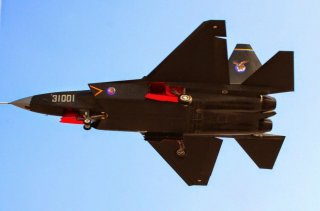China's 'F-35': Could Beijing Build a New Stealth Fighter?
The smaller, lighter FC-31 looks remarkably like the U.S. F-35 stealth fighter. It also resembles the F-35 in function.
Another Chinese stealth fighter is under development.
Or will it just be an upgrade of an existing stealth aircraft?
The Shenyang Aircraft company, which manufactures China’s most advanced warplanes, recently announced plans to develop a new fourth-generation fighter (in Chinese nomenclature, “fourth generation” is equivalent to Western “fifth-generation” aircraft such as the F-22 and F-35 stealth fighters).
“The company aims to make breakthroughs in its fourth-generation fighter jet program by boosting related technologies, including additive manufacturing, control over surface electromagnetic defects, and automated fiber placement, so that the aircraft can be successfully developed,” noted China’s Global Times news site.
“The company announced that it is also exploring next-generation aircraft including research on technologies like thermal adaptation and integration of structure and function,” Global Times said. “A technological system for the next-generation aircraft will be gradually formed as the company conducts test production and research.”
But is the new fighter meant for the People’s Liberation Army Air Force as a land-based fighter, or the People’s Liberation Army Navy as the fighter of choice for China’s growing fleet of aircraft carriers?
Shenyang’s announcement, which was posted on Chinese social media app WeChat, included a photo of an FC-31 stealth fighter, Shenyang’s only fourth-generation fighter that was once a candidate to be the Chinese navy’s carrier jet. Instead, the Chinese navy chose a navalized version of Chengdu Aerospace Corporation’s land-based J-20, China’s first stealth fighter. The Chinese air force already flies the J-20.
Does the FC-31 photo signify anything? That an announcement of a new Shenyang jet was accompanied by a photo of an existing Shenyang jet is not a surprise. If Lockheed Martin were to announce the development of a new fighter, the press release might very well include a photo of the F-35 stealth fighter as a tangible example of the company’s work.
However, the photo could also indicate that Shenyang intends the new aircraft to unseat the J-20 as China’s naval fighter. Though both Shenyang and Chengdu are subsidiaries of the state-owned Aviation Industry Corporation of China (AVIC), they are also competitors just like the MiG and Sukhoi design bureaus under the Soviet Union.
Wang Ya’nan, chief editor of Beijing-based Aerospace Knowledge magazine, told the Global Times that “it makes sense to speculate the statement is referring to an improved version of the FC-31, as the current versions are only prototypes. The Chinese Navy needs a more advanced fighter jet on its aircraft carriers in the future, and the FC-31, when customized for that purpose, would be a good choice,” Wang predicted.
The twin-engine J-20 Mighty Dragon is a heavier aircraft that resembles the U.S. F-22 or Russian Su-57 stealth fighters. By virtue of being China’s first stealth fighter, the J-20 has generated a lot of buzz—but few solid technical details. It reportedly has a maximum take-off weight of 37 tons and may be armed with very-long range PL-15 missiles that allegedly can hit targets 200 kilometers (125 miles). The J-20 seems to be a heavy, long-range stealth sniper designed to pick off distant targets with air-to-air missiles—most especially the airborne control aircraft and tanker planes that are the backbone of U.S. airpower.
The smaller, lighter FC-31 looks remarkably like the U.S. F-35 stealth fighter. It also resembles the F-35 in function: a multirole aircraft that can perform air superiority and strike missions. But the twenty-five-ton FC-31 seems to have a checkered past: first unveiled in 2012, it has neither been purchased by the Chinese air force—for which it was originally designed—or foreign nations. Adapting it for use on Chinese aircraft carriers may have been something of a desperation move.
Both aircraft have pros and cons as carrier jets. The J-20 has a longer range and a bigger payload than the FC-31 and has the advantage of already being operational. But a larger plane takes up more space, so fewer J-20s could be taken aboard an aircraft carrier. The Chinese air force has probably bought fewer than fifty J-20s since the aircraft was unveiled in 2011, which suggests China isn’t interested in mass-producing the J-20 as a land/carrier-based plane like the F-35.
An upgraded FC-31 would be smaller and probably cheaper than a navalized J-20. But it would offer less range and payload, and the FC-31 is still an untested design. In any event, both aircraft may suffer from the Achilles heel of Chinese warplanes: a lack of reliable jet engines.
On the other hand, both planes would certainly be better than China’s current carrier-based jet, the infamous J-15 fighter jet currently flown by the carriers Liaoning and Shandong. The J-15 is an unlicensed copy of Russia’s Su-33 carrier jet, which was a 1980s derivative of the Su-27K land-based fighter. China had acquired a T-10K-3, a Su-33 prototype, from Ukraine and then reverse-engineered it—only to end up with an aircraft notorious for crashing.
Michael Peck is a contributing writer for the National Interest. He can be found on Twitter and Facebook.
Image: Reuters.

